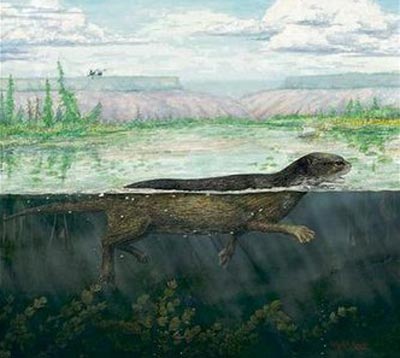Seals used to live on land
Canadian scientists have found the missing link in the evolution of seals and walruses. It is the fossil of a otter-like animal, which has membranes on its feet and can live both on land and underwater.

Seals have moved both on land and underwater.Photo: Reuters.
A group of paleontologists from the Canadian Museum of Nature found fossils in the lake bed when exploring Devon Island, in the Arctic in 2007. The fossil intact ratio is 65%. This ancient animal is called Puijila darwin or a walking seal about 110 cm from the nose to the tail.
Its body is quite like an otter, but the skull is like a seal. This is a meat-eating mammal with large teeth, short muzzle, strong jaw, elongated, slender body. The long tail allows Puijila darwin to move in the water at great speed. Seals know to live in freshwater lakes about 20-24 million years ago, can move easily on land, underwater and belong to the group of fins.
However, this is not a direct ancestor of today's seals. Paleontologists believe that the group of fins (seals, sea lions, walruses) used to live on land before entering the sea. However, they encountered difficulties in the research process because there was no evidence.
In the past, feline animals were thought to evolve from Enaliarctos - a group of five species that once lived along the west coast of North America before entering the water. Enaliarctos is the oldest group of fins animals that palaeontologists have ever discovered. Although they lived at the same time as the known seals, they had flippers and oblong designs (suitable for life in the ocean).

Scientist Natalia Rybczynski studies fossils of known seals.Photo: Reuters.
'Enaliarctos does not say anything about the evolution of fins, although we know they evolved from terrestrial mammals. So the fossil that we found was the missing link in the seal from the land to the water of the seal , 'said Natalia Rybczynski, the lead researcher.
The research team wanted to know why the seals lost their long tail when entering the water. When some mammals, such as whales and manatees, move from the ground to the water, they still retain the tail. For some reason fins have not done so. "Now we know they have a choice, meaning they have a tail but don't use it ," Rybczynski commented.
- Seeing the mini version yourself, seals do surprises
- The secret to pre-existing natural danger of hat seals
- Seals with penguins - the most fruitful love of the earth appeared
- 7,000 Russian seals are in danger of being destroyed
- Seals stray between forests in Sweden
- Seals of film production in the United States
- Beam of photos: The sunshine smile of a seal
- Strange image: Seals cut shark meat
- The seal seals down the cliff for fear of people
- The mystery of 130 massive dead seals in the world's deepest lake
- Elephant seals 'sleep' during dive
- What would happen if the Earth's sea and land swapped? Hell is full of centipedes waiting for you
 Discovered an ancient centipede fossil 99 million years old
Discovered an ancient centipede fossil 99 million years old Discovered bat-like dinosaurs in China
Discovered bat-like dinosaurs in China Discovered a 200-year-old bronze cannon of the coast
Discovered a 200-year-old bronze cannon of the coast Discover 305 million-year-old spider fossils
Discover 305 million-year-old spider fossils